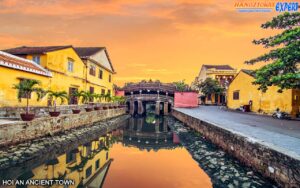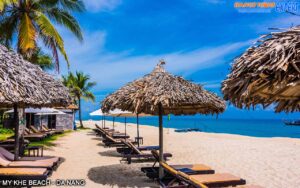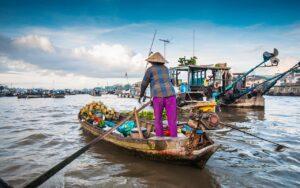
BEST TIME TO VISIT VIETNAM
 Vietnam’s unique geography creates a range of weather patterns, with both tropical and temperate zones. While March to May offers the best weather countrywide, there is no bad time to visit Vietnam, as there is always some part of the country with holiday skies. Below is a guide to climate of Vietnam’s major regions and destinations, so you know what to expect during your trip.
Vietnam’s unique geography creates a range of weather patterns, with both tropical and temperate zones. While March to May offers the best weather countrywide, there is no bad time to visit Vietnam, as there is always some part of the country with holiday skies. Below is a guide to climate of Vietnam’s major regions and destinations, so you know what to expect during your trip.
NORTHERN PATTERNS
The North of Vietnam is generally cooler than other South East Asian regions in the same longitude. It experiences two main distinct seasons. In winter months, the weather gets colder and colder from November to March and considerably warmer in April (a leap into summer). This is also time to observe much cloud and frequent drizzle. The average winter temperature is 17.2°C (62.9°F).
Particularly, the mountainous areas (Northwest) are often much colder, temperature may keep below 10°C (50°F) for long period. Ice and snow even cover Hoang Lien Son Mountains and nearby Sapa town for some times with the lowest record of -3°C (26.6°F) in Feb 2008.
In the summer (from May to October), the whole region is quite hot. Temperature may rise to 37°C (98.6 °F) in the peaks of June and July. Hanoi and coastal provinces around the Red River Delta generally enjoy equitable weather with high average humidity (80%) all year round though they may occasionally be subjected to typhoons and heavy rain in late summers (September to November).
Vietnamese people even identify four seasons in the Northern provinces (from Hai Van Pass toward the north) with their distinct features: pleasant spring (typically March-April) and autumn (October-December), a chilly winter (December- February) and a hot summer (June – July).
Weather in Hanoi
 December – March: cool to cold, misty, cloudy
December – March: cool to cold, misty, cloudy
April – June: warm to hot, clear skies, sunny
June – August: hot, humid, rainy
September – November: cool, clear skies, sunny
The best time to visit Hanoi is usually from April to June or from September to December. From April the days are normally hot, occasionally above 30 degrees with clear skies. September to November sees cooler temperatures of around 25 degrees and sunny skies — perfect for exploring the capital.
If you’re coming to Hanoi in June, expect soaring temperatures with humidity highs of 40 degrees, and the rainy season is full swing (June to August). December is cool, misty and atmospheric, however from late December until March temperatures are surprisingly cold with lows of 10 degrees. You’ll want to bundle up.
Weather in Halong Bay
 December – March: cool to cold, misty, cloudy
December – March: cool to cold, misty, cloudy
April – June: warm to hot, clear skies, sunny
June – August: stormy, hot, humid
September – November: mix of sun and clouds, warm to cool
If you’re coming to Halong Bay, try to visit from April to June or September to November. You’ll have a better chance of enjoying sunny skies and pleasant temperatures. Other times of year, downpour or heavy mist is common, and tropical storms can sometimes cause cruise cancellations. However, if you’re on the water during this time you can experience a more mystical side of Halong Bay, with its famous karsts shrouded in mist. Temperatures in January can be frigid, so be sure to bring warm layers.
Weather in Sapa
 December – March: chilly, misty, cloudy
December – March: chilly, misty, cloudy
April – June: warm, clear skies, sunny
June – August: stormy, warm, humid
September – November: cool, clear skies, dry
Vietnam’s Northern destinations such as Sapa have a much cooler climate than the rest of the country, particularly from late December until March. Sapa sees the occasional snowfall in January, so be prepared. Hotels in the area are equipped with heated blankets and local spas offer herbal baths for you to soak in and warm up.
Sapa is near-perfect in late April, as flowers bloom and skies are clear. Early October is also lovely, as its impressive tiered rice paddies turn golden just before harvest.
CENTRAL PATTERNS
The Central Vietnam with two sub-regions, coastal lowlands and central highlands, can be seen as an in-between climatic area of the North and the South.
The coastal strip is usually dry and hotter than the rest in the summer, as the Truong Son Mountains do not allow it to enjoy most rainfall of south-western monsoon (from April to October). Unprotected coasts in their turn, however, make it wet and colder than the rest in winter-monsoon season (from November to March).
Also, storms and typhoons strike this area more frequently than the northern coasts in summer months (from July to November). The Central Highlands in particular enjoys nearly double the average rainfall of the country.
Two biggest towns in this plateau, Dalat and Pleiku, are ideally cool throughout the year. Near-the-south coastal cities, Quy Nhon, Nha Trang and Phan Thiet, on the contrary, experiences steamy hot weather (21°C-32°C / 70°F-90°F) all year round.
Weather in Da Nang
April – August: Dry season
September – March: Monsoon season
Hottest months: June–August (with highest average temperature of 35°C)
Coolest months: November–January (with lowest average temperature of 18°C)
The weather in Da Nang is formed by a tropical monsoon climate, with mild temperatures throughout the year. A popular holiday destination among travellers, Da Nang has beautiful beaches such as My Khe Beach and Non Nuoc Beach. UNESCO-listed Hoi An and My Son Sanctuary are just a short drive away.
Weather in Huế
 September-February: cool to cold, rainy, cloudy
September-February: cool to cold, rainy, cloudy
March-August: warm to hot, sunny, clear skies
Huế, home of Vietnam’s last reigning dynasty, has a late rainy season, with storms and days that are wet and cool from September to February. Look out for occasional flooding from September to November. In the early months of the year, temperatures go down to 15 degrees, and January often sees a bit of mist. The rest of the year is dry, and in July you’ll have perfect beach weather, with highs of 35 degrees.
Weather in Hội An
 September – January: rainy, cool, cloudy
September – January: rainy, cool, cloudy
February – August: warm to hot, sunny, clear skies
Hội An is one of the country’s picture-perfect places, but starting in September, tropical storms hit Central Vietnam hard. March is an excellent time to see Hội An when the fields, gardens and streets are awash in bright blossoms and soothing greens. From May to August, the town can be hot, and you’ll want to head to the beach to cool off. In the late months of the year, from September to November, Hội An sees a lot of rain and even a few small floods. The temperatures begin to dip and reach their coldest point in January, warming up just before the Vietnamese new year.
Weather in Nha Trang
 September to December: cool, rainy, cloudy
September to December: cool, rainy, cloudy
January – August: hot, sunny, clear skies
Nha Trang gets the more than 300 days of sunshine per year, the most out of the whole country. Some monsoons hit between September and December, but in general Nha Trang has the shortest rainy season in Vietnam. Most of the year, the city has a pleasant temperature, with cooling sea breezes, although you should expect lots of sun and hot days from July until August.
Weather in Da Lat
April – October: rainy, warm to hot, cloudy
November – May: cool to cold, dry, clear skies
Nestled in the central highlands, this charming mountain city is appreciated for its temperate climate. The air in Da Lat is always fresh and crisp. The mountains provide consistent cool temperatures and pleasant breeze, making it a great spot to escape the heat of the cities. Da Lat’s rainy season is from April until October. Temperatures are generally consistent with lows of 20 degrees in January and highs of 30 degrees in July.
SOUTHERN PATTERNS
The South of Vietnam, merely 8 degrees north of the Equator, is typical of humid tropical climate which is excellent for growing rice. The region’s temperatures experience little variations in a year (around 27-32°C/80-90°F).
There are two main seasons: the rainy and the dry. During the rainy/monsoon season (from May to November), downpours are expected to happen nearly every afternoon, resulting in occasional street flooding in and around Saigon. In the dry season, it is hot from late February to April then slightly cooler when first downpours come.
Ho Chi Minh city (Saigon) enjoys rather equitable tropical climate with high humidity all year round. December to March is said to be the most pleasant time to hit this region’s center.
Weather in HCMC & the Mekong Delta
 May to November: sporadic rainfall, hot, humid
May to November: sporadic rainfall, hot, humid
December to April: clear skies, hot, sunny
Southern Vietnam and Ho Chi Minh City have consistent temperatures year-round. HCMC is either hot and dry or hot and rainy, although there are some pleasant fresh days early in the year, and some scorching days mid-year. Temperatures are normally around 30 degrees, with sunshine. From May to November, the wet season brings a dependable afternoon downpour, usually lasting a few hours.
Weather in Phú Quốc
July – September: stormy, hot, humid
October – June: clear skies, hot, sunny
The island of Phú Quốc has some of Vietnam’s best beaches and promises balmy weather year-round. However, you might want to avoid visiting in the rainy season, from July through September. During these months some storms roll through, making ferrying dangerous and the beaches less than ideal. The rest of the year is hot and dry, and Phú Quốc is a sublime tropical escape in December and January.
Note:
In all, Vietnam climate is so diverse that there is almost no definition of an average temperature for the whole country. Thanks to these regional variations in weather, generally, you can drop in Vietnam at any time of year.
Commonly, based on the duration of your stay, you should plan to catch the good weather and places by either dropping in Saigon in February or March then following the coast to north or hitting Hanoi in October-November then tracing southward. The choice is entirely yours.
Whichever way you choose, however, it is important to keep your luggage as light and loose as possible. Vietnam is not subject to extreme weather, thus loading up with clothes is never necessary. And a final word, stay with us for up-to-minute information on Vietnam’s weather and tourism hot news.
If you plan to visit Vietnam at time of the Tet (Vietnamese New Year), the biggest festival in the calendar, which falls in late January or early February. It’s a nice idea in principle, but not in practice, as the whole country is on the move and prices rise dramatically due to tourist facilities (hotels, restaurants, etc) shut down and most staff off for their family.
Should you have any further questions please feel free to contact us. We would love to hear from you.
If you have a story to share or a question that has not been answered on our website, please contact us to get in touch with us via the contact details listed below:
- Address: Ho Guom Plaza Building, 102 Tran Phu Road, Ha Dong Dist, Hanoi city, Vietnam.
- Phone: +84 961738229
- Hotline: +84 975558866 (24/7/365 – Whatsapp/Viber/Line)
- Email: [email protected]
- Skype: hanoitoursexpert
- Facebook: facebook.com/hanoitoursexpert

